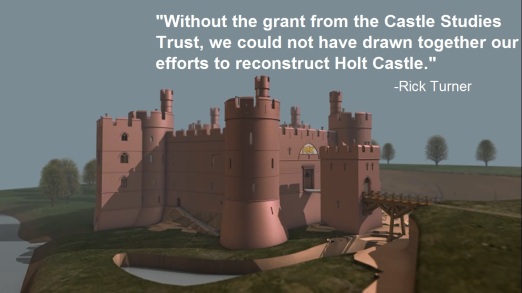What is the Castle Studies Trust?

A blend of military architecture and domestic use has produced buildings as diverse as Carlisle and Edinburgh, both still used by the British Army, and Bodiam and Stokesay, designed at least partly for show and domesticity. Examining the medieval castle leads to an examination of medieval society.
The Castle Studies Trust was founded in 2012 to fund projects advancing castle studies. This year’s survey at Caus is the first time it has been investigated in-depth by archaeologists. This is despite the fact it is a one of the largest castles in Shropshire.
[Click here for Castle Studies Trust interview with Michael Fradley]
We used the latest survey techniques at Gleaston (Cumbria), using a drone to conduct a photogrammetic survey because the building is too precarious for people to enter. Given the perilous state of the castle, this gives us an invaluable record. The geophysical survey at Pembroke (Pembrokeshire) is using up-to-date technology to give higher resolution results than have previously been available. At Holt (Wrexham) only a small stump of masonry survives from this once impressive castle. By bringing together information from documentary sources, historic illustrations, and recent excavations it has been possible to recreate how it would have appeared c1495.
Importantly, the projects we have supported have the potential to lay the foundations for further investigation. The survey of the Ballintober (County Roscommon) led to community excavations in 2015 and 2016. And this year the local community at Gleaston braved the British weather to carry out a geophysical survey of the enclosure.
Some of the sites we work at are designated ‘At Risk’ meaning there is a genuine threat to the future of these sites. This is the case at Gleaston and hope that the recent work will spur others to join the process of conservation. At Wressle Castle in Yorkshire the examination of the landscape was an aspect of a programme of work preserving the castle, which in 2015 led to its removal from the ‘At Risk’ register. Interestingly by looking at the landscape we learnt that the castle had been laid out over a pre-existing village, showing the power of medieval magnates in reshaping the landscape and directly affecting the local populace.
At Pleshey (Essex) details of excavations in the 1970s and 1980s have sat unpublished for decades. This untapped resource is being brought to the public with our support. That is an important aspect of our work: bringing this information to the public. As such you can find all the finished reports on our website, and the reconstruction of Holt is now available on Wikipedia! And you can now explore the ruins of Gleaston from the comfort of your home.
For many castles there is no documented history at all, but some of the sites we have looked at have had links to some of the Middle Age’s most prominent figures. Holt was the treasure house of Richard II. Pleshey was built by William de Mandeville, one of the richest men in 12th-century England. Tibbers (Dumfriesshire) was a battleground in the Anglo-Scottish Wars of the early 14th century and was captured by Robert the Bruce. Pembroke Castle in Wales was the birthplace of Henry VII.
There are thousands of castles in England, Ireland, Scotland, and Wales. A huge number are either poorly understood or have never had any proper archaeological investigation. The work the Castle Studies Trust is doing is pushing forward our understanding of one of the integral parts of medieval society.
If you would like to learn more about the work of the Trust you can follow us on Twitter and Facebook or sign up to our newsletter.
Richard Nevell is on the board of the CST and is studying for a PhD in castle slighting.

Reblogged this on Richard the Castellan.
LikeLike